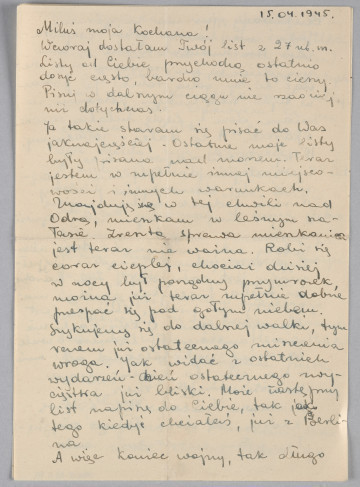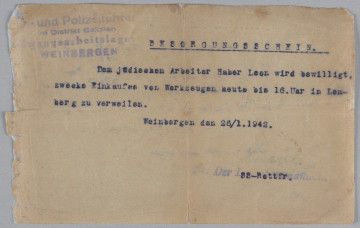
A letter
1945
Museum of the history of Polish Jews
Part of the collection: Memorabilias of the Diatłowicki family
Just over a year after the Diatłowicki family was deported from Łuck to Kazakhstan, the Soviet-German war began (https://sztetl.org.pl/pl/slownik/wybuch-wojny-niemiecko-radzieckiej-1941). It was the reason for the evacuation of many industrial plants and offices to the east. The events related to the transfer of offices to the east contributed to the maintenance of the five-person Diatłwicki family until their return to Poland in 1946. The Grandfather of the Donor, Józef Diatłowicki, while hurriedly packing the most necessary utensils before the deportation (for which families usually received only two hours from the Soviet authorities), instinctively grabbed a diamond to cut glass. After arriving in Kazakhstan, it turned out that he was the only one in possession of a tool enabling the cutting of glass panes from which the signs for the plants were to be made (after placing behind the glass, even the information on the paper remains resistant to weather conditions).
Initially, Józef Diatłwicki received an offer to buy the tool from him. However, he did not agree to any of the offers. Having stocked up on other necessary tools, he became a local monopolist for cutting glass into signboards. When starting work, he also decided that he would not be remunerated for it in the form of money. In the circumstances in which the family lived, food products or items that could be easily converted into food were more valuable. As an example of such an exchange, Jerzy Diatłowicki, the grandson of Józef born in Kazakhstan, gives a cart full of hay, which was worthless to humans, but as food for animals, it could be exchanged with the farmer for agricultural products.
The donor recalls that he felt part of the Jewish community only in the face of the events of March 68 '(https://sztetl.org.pl/pl/slownik/marzec-1968-w-polsce). As a student at the University of Warsaw (at the same time at the Faculties of Philosophy and Sociology), he became involved in the activities of the student strike committee, of which he became a member and then a delegate. Soon after, he was accused of irresponsible attitude to the Military College, as a result of which he was expelled from the university, and then drafted into military service. Nowadays, Jerzy Diatłowicki is engaged in journalistic and journalistic activities. The device consists of a metal blade resembling a hammer and a handle made of ivory. On both sides of the blade there are recesses in which small fragments of a diamond have been placed, enabling the cutting of the glass. The device consists of a metal blade resembling a hammer and a handle made of ivory. On both sides of the blade there are recesses in which small fragments of a diamond have been placed, enabling the cutting of the glass.
Marta Frączkiewicz
Author / creator
Dimensions
cały obiekt: height: 15 cm, width: 2,5 cm
Technique
Casting, cutting, bending, joining, grinding
Material
Metal, bone, diamond
Creation time / dating
Creation / finding place
Owner
POLIN Museum of the History of Polish Jews
Identification number
Location / status

1945
Museum of the history of Polish Jews
1944
Museum of the history of Polish Jews

1942
Museum of the history of Polish Jews
DISCOVER this TOPIC
Museum of King Jan III's Palace at Wilanów
DISCOVER this PATH
Educational path